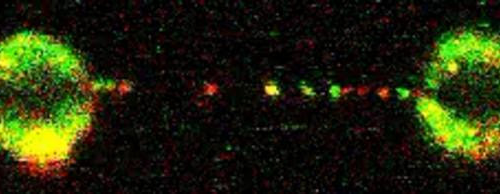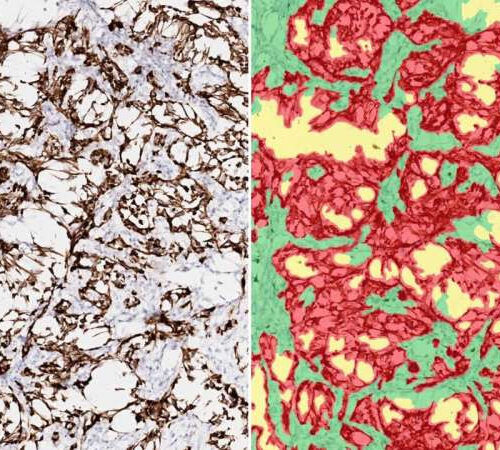News Release 12-Aug-2024 Macrophages exposed to low levels of ‘eat me’ antibodies consume more later Peer-Reviewed PublicationUniversity of California – Santa Barbara (Santa Barbara, Calif.) — The body has a veritable army constantly on guard to keep us safe from microscopic threats from infections to cancer. Chief among this force is the macrophage, a white...
Tag: <span>cancer treatments</span>
FANCI that! Decades long mystery of how DNA damage by sunlight, alcohol and pollution is identified so it can be repaired, is solved. Opens up opportunities for improved cancer treatments.
Peer-Reviewed PublicationMedical Research Council (MRC) Laboratory of Medical Sciences video: A single molecule of DNA (not directly visible) is captured using microscopic beads (the large circles). Each of the red, green or yellow dots moving between the beads represent a FANCD2I-FANCI protein complex sliding along the DNA molecule, monitoring it for damage. Credit: MRC Laboratory...
New insight into protein could pave the way for new cancer treatments
by Anna Björklund, Identification of a conformational switch in c-MYC. a Overview of the MD strategy employed to identify regions that exhibit probe-induced conformational changes. b Normalized frequency distribution of Rg computed from the ensemble of structures generated from explicit solvent MD simulations in water (black) and water + benzene (red) for all nine c-MYC...
Cannibalistic cells could provide an edge in future cancer treatments
By Paul McClure Researchers have added an active Rac2 protein to macrophages, causing them to cannibalize other immune cells Depositphotos Following a trail of evidence that started with a study of fruit flies nearly 25 years ago, researchers have found adding a hyperactive form of the protein Rac2 to macrophages, immune cells that eat pathogens, causes...
How popular steroids could interfere with some cancer treatments
by Cold Spring Harbor Laboratory Two looks at mouse tumors. Left: staining by the Cold Spring Harbor Laboratory Animal & Tissue Imaging Shared Resource. Right: segmenting by Dominik Loiero in the lab of University of Zurich Assistant Professor Viktor Koelzer. The red segments on the right are cancer cells. Credit: Janowitz lab/Cold Spring Harbor Laboratory Immunotherapy...
Defining plasma dose for potential future cancer treatments
AMERICAN INSTITUTE OF PHYSICS IMAGE: PLASMA-ACTIVATED MEDIUM FOR CANCER TREATMENT. CREDIT: HE CHENG, JINGYI LUO, KE SONG, FENG ZHAO, DAWEI LIU, LANLAN NIE, AND XINPEI LU WASHINGTON, June 28, 2022 – Chinese researchers may have found a new approach to treat cancer by using a plasma treatment to induce apoptosis, the death of cancer cells,...
Cell division finding could lead to new cancer treatments
A protein called CDC7, long thought to play an essential role early in the cell division process, is in fact replaceable by another protein called CDK1, according to a study by investigators at Weill Cornell Medicine and the Dana Farber Cancer Institute. The finding represents a fundamental advance in cell biology and may lead to new cancer therapies...
Repurposed cancer treatments could be potential Alzheimer’s drugs
by National Institutes of Health Credit: CC0 Public Domain Existing and emerging cancer drugs could be repurposed as therapies to be tested in clinical trials for people at genetic risk of Alzheimer’s disease, according to a new study published in Science Advances. Research combining analysis of brain protein alterations in these individuals as well as laboratory...
Cancer cell growth findings may hold promise for future cancer treatments
by Karolinska Institutet Fig. 1 Elevated eIF4A3 expression in cancer is correlated with a high RiBi rate and poor prognosis. (A) Representative GENT2 (Gene Expression database of Normal and Tumor tissues 2)-derived comparison of eIF4A3 mRNA levels in various cancer types and their normal counterpart tissues (****P < 0.001). (B) Correlation of eIF4A3 mRNA expression levels...
Princess Margaret Cancer Centre researchers discover key stem cell dormancy mechanism which could help unlock future cancer treatments
UNIVERSITY HEALTH NETWORK IMAGE: DR. STEPHANIE XIE, AFFILIATE SCIENTIST, PRINCESS MARGARET CANCER CENTRE, UNIVERSITY HEALTH NETWORK. CREDIT: UHN Princess Margaret Cancer Centre researchers have made new findings that provide a broader understanding of how dormant hematopoietic stem cells are activated and could pave the way towards therapeutic treatments for a number of cancers. The team...







